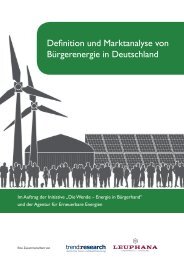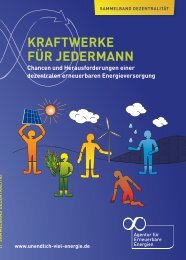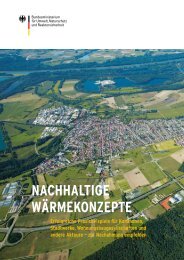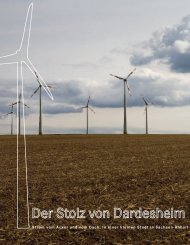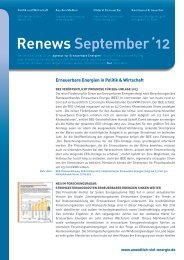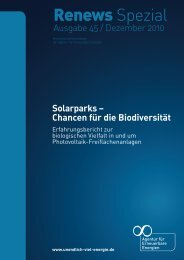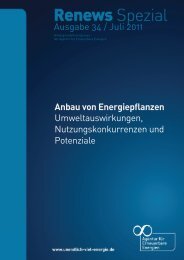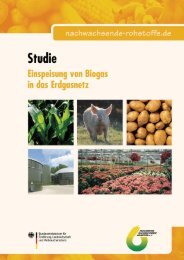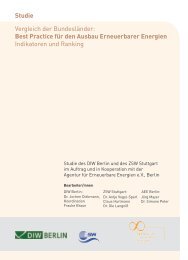Solar parks - Agentur für Erneuerbare Energien
Solar parks - Agentur für Erneuerbare Energien
Solar parks - Agentur für Erneuerbare Energien
You also want an ePaper? Increase the reach of your titles
YUMPU automatically turns print PDFs into web optimized ePapers that Google loves.
Renews Special Best practice recommendations Issue 45 | p 16 p 17 | Issue 45 Renews Special <strong>Solar</strong> <strong>parks</strong> – Opportunities for Biodiversity<br />
<strong>Solar</strong> <strong>parks</strong> – Best practice recommendations: Nature conservation measures<br />
<strong>Solar</strong> <strong>parks</strong> can enrich the biological diversity of sites. Depending on the type of site, an improvement for flora and<br />
fauna will be more or less difficult to achieve. The opportunities for improvement can be increased by following a<br />
number of nature conservation measures during the planning, building and operating phases.<br />
Planning Building Operating<br />
Site selection:<br />
Unproblematic sites from<br />
a nature conservation<br />
perspective are usually<br />
contaminated brownfield<br />
sites, sites along<br />
transport routes, former<br />
agricultural land, landfill<br />
sites and slagheaps.<br />
Environmental<br />
rehabilitation and<br />
local planning to draw<br />
up compensatory<br />
measures:<br />
The construction of solar<br />
<strong>parks</strong> on brownfield<br />
sites can go a long way<br />
towards undoing existing<br />
environmental damage<br />
by unsealing sites and<br />
removing contamination.<br />
Compensatory measures<br />
can include identifying<br />
refuges and maintained<br />
areas for animal and<br />
plant life.<br />
Taking local conditions<br />
into account in the<br />
environmental impact<br />
assessment:<br />
Protective measures for<br />
flora and fauna can be<br />
identified and recorded<br />
as conditions in the<br />
environmental impact<br />
assessment.<br />
Ecological project<br />
planning and<br />
monitoring:<br />
Environmental<br />
construction monitoring<br />
can involve nature<br />
conservation expertise<br />
in the planning,<br />
construction and<br />
operation early on and<br />
throughout the project.<br />
Avoiding soil sealing:<br />
By dispensing with<br />
foundations, up to 99%<br />
of the area can remain<br />
unsealed.<br />
Contributing towards<br />
conserving the regional<br />
genetic diversity of<br />
plants:<br />
If plants are sown or<br />
planted, the use of<br />
native, plants and seeds<br />
appropriate to the site<br />
in question can promote<br />
regional genetic diversity.<br />
Avoiding barrier effects<br />
caused by fencing:<br />
Corridors through large<br />
plants and a suitable<br />
ground clearance<br />
enable solar <strong>parks</strong> to<br />
be integrated in the<br />
surrounding area.<br />
Minimizing the canopy<br />
effect and reflections:<br />
The impact can be<br />
reduced through suitable<br />
construction measures.<br />
Light reflection and glare<br />
do not irritate birds.<br />
Knowledge gain through<br />
monitoring<br />
Continual environmental<br />
monitoring helps improve<br />
future measures for the<br />
protection of flora and<br />
fauna.<br />
Site maintenance<br />
Regular mowing or<br />
sheep grazing can<br />
maintain or create<br />
species-rich habitats<br />
within the solar park.



